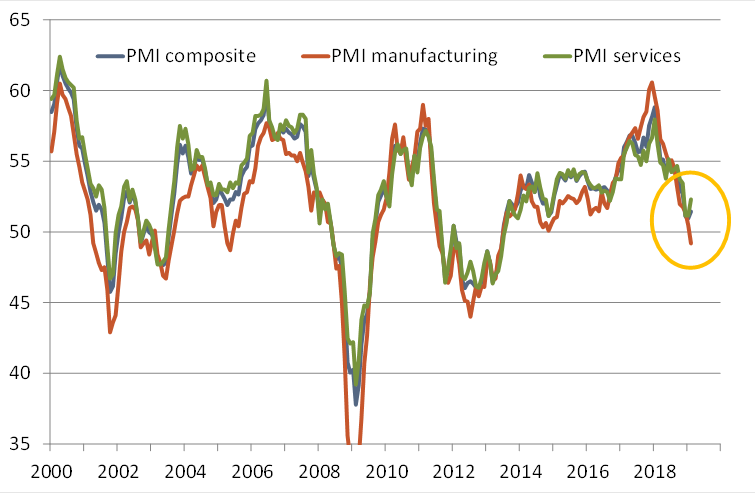The Euro Slips on Data Showing Eurozone Economy Struggling to Escape Stagnation on Ongoing Manufacturing Slump: Eurozone PMIs

Image © Adobe Stock
The Euro exchange rate complex was put on the back-foot on Thursday, February 21 after Eurozone-wide activity data for February showed the area's economy continues to be weighed down by an under-performing manufacturing sector, however the services sector is appearing to defy the gloom.
Preliminary February IHS Markit PMIs released Thursday show that the Eurozone's service sector continues to expand, however the manufacturing sector continues to shrink.
The Services PMI read at 52.3 in February, a beat on the 51.5 forecast by markets, and a beat on the previous month's 51.2.
Manufacturing PMI read at 49.2, below the 50.3 forecast by markets and below the 50.3 forecast a month prior. Any reading below 50 suggests contraction. The Composite PMI read at 51.4, above expectations for 51.1.
The disappointing numbers saw the Euro slip against the Dollar with the Euro-to-Dollar exchange rate dropping from 1.1354 ahead of the release of the German PMI data at 09.00 GMT to 1.1330 at the time of writing, with another sharp leg lower coming following the release of the Eurozone-wide PMIs.
The Euro-to-Pound exchange rate had already been under pressure but the sell-off accelerated on the release of the data with the Euro-to-Pound exchange rate being quoted at 0.8667, having been as high as 0.8703 earlier in the day.
"The Euro has experienced a topsy-turvy morning today amid the release of six crucial PMI surveys spanning France, Germany, and the eurozone. While the French recovery in both services and manufacturing built on the bottoming out in ZEW and consumer climate figures earlier in the week, the big story remains the divergence between services outperformance and manufacturing decline in the eurozone. German manufacturing has long been a driver of growth throughout Europe, yet with the manufacturing PMI now at a six-year low, it comes as no surprise that we have seen the euro reflecting the impact this has upon eurozone growth prospects," says Joshua Mahony, Senior Market Analyst at IG.
Image courtesy of Berenberg.
The standout reading will of course be the disappointing manufacturing number, almost certainly a result of the 74-month low reported in Germany's Manufacturing PMI released earlier in the day.
"Today’s PMIs imply the challenges facing the German manufacturing sector are even larger than previously thought, and increasingly burden the outlook for the entire Euro area. Discussion on what the ECB could do will pick up at the March meeting," says Jan von Gerich, an economist with Nordea Markets.
According to IHS Markit, manufacturing sector new orders decreased to the greatest extent in almost six years, with new export orders also falling at a faster pace than in January.
There were signs of stabilisation in French economic activity, despite reports of lingering disruption caused by the ‘yellow vest’ protests.
“The Eurozone economy remained close to stagnation in February. The flash PMI lifted only slightly higher during the month, continuing to indicate one of the weakest rates of expansion since 2014. The survey data suggest that GDP may struggle to rise by much more than 0.1% in the first quarter," says Chris Williamson, Chief Business Economist at IHS Markit .
IHS Markit say Germany is on course to grow by 0.2%, buoyed by its service sector, but France looks set to stagnate or even contract very slightly.
The rest of the region is meanwhile suffering its worst spell since late 2013, with growth having slipped closer to stalling in February.
“Weaker order books were linked to a combination of intensifying headwinds and concerns, including global trade protectionism worries, Brexit, the downturn of the auto sector, increased political uncertainty and anxieties regarding the broader economic outlook. Rising risk aversion has consequently dampened demand, investment and spending," says Williamson.
Concerning the outlook, economist Florian Hense with Germany's Berenberg Bank believes the downturn in the Eurozone economy might be bottoming, something that could underpin the Euro and protect it from further losses.
"Driven by stronger activity among domestically-oriented services in Germany and France, the Eurozone PMI composite edged higher from 51.0 to 51.4 in February (see chart 1). Although still close to the stagnation level of 50, the first gain since last August adds to the evidence provided by this week’s slightly better German ZEW expectations and Eurozone consumer confidence that the Eurozone economy may soon hit bottom. Although the grey winter is not over yet, the stability of the service sector supports our hope that spring could indeed be brighter," says Hense, cautioning that, "these are just the first positive signs".
Analyst Radu-Gabriel Cristea with Barclays says forward-looking indicators are calling for stabilisation, on the back of still resilient domestic demand that mainly spurs services output, however the outlook for manufacturing remains bleak. "Manufacturing order books continue to shrink, particularly on the external side, but services new business flows came in overall strongly, bringing hopes of further acceleration. Given their sheer size in the euro area economy, the backdrop seems rather positive – composite new orders edged up marginally, remaining close to stagnation levels," says Cristea.
Time to move your money? Get 3-5% more currency than your bank would offer by using the services of foreign exchange specialists at RationalFX. A specialist broker can deliver you an exchange rate closer to the real market rate, thereby saving you substantial quantities of currency. Find out more here.
* Advertisement





